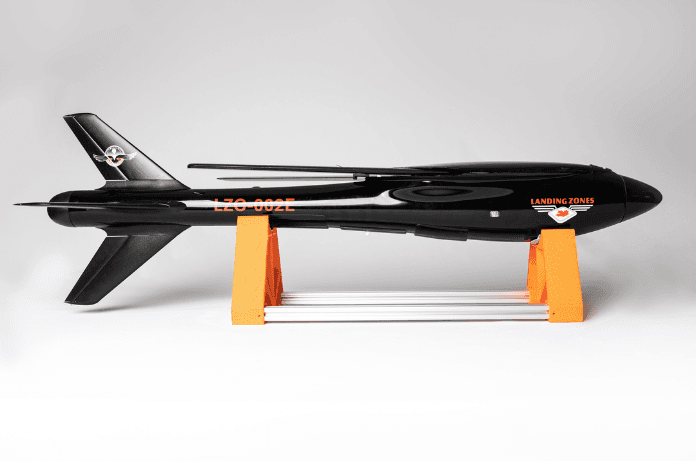In an era where military strategies demand rapid, covert, and highly efficient delivery systems, Landing Zones Canada Inc. has introduced a revolutionary solution. It is Eagle, the world’s first advanced, stealthy, balloon-launched high-altitude military glider delivery system. This state-of-the-art drone transforms the landscape of military logistics and strategic operations by combining the stealth and altitude of aerial systems with the precision and adaptability of gliders.
The advanced drone launches from high-altitude balloons, soars into the stratosphere, and then deploys a specialized glider. This unique combination of Eagle Advanced Payload Delivery System (APDS) allows for remarkable stealth. Thereby, evading detection by traditional radar and air defense systems. By launching from such high altitudes, the military-grade drone can bypass conventional airspace routes. This capability minimizes its vulnerability to interception and enhances mission success, whether in contested or hostile environments.
A New Era in Military Delivery Systems
The Eagle APDS can provide exceptional stealth and efficiency in delivering critical payloads to challenging environments. By using high-altitude balloon launches, the system can deploy gliders from the stratosphere. This ensures rapid and covert delivery of supplies, equipment, or intelligence assets to designated locations.
Key Features and Capabilities
- Stealth and Low Radar Signature: The Eagle Glider is designed with advanced materials and aerodynamics. It can minimize its radar cross-section, making it difficult for adversaries to detect and track it in hostile airspace.
- High-Altitude Deployment: Launched from high-altitude balloons, the system can reach stratospheric levels, allowing for extended range and the ability to bypass ground-based threats.
- Autonomous Navigation: Equipped with sophisticated onboard systems, the Eagle can switch between autonomous and human-controlled operations to navigate to its target ensuring mission success under challenging conditions.
- Variable Speed Operation: The glider boasts a variable wing profile, enabling it to operate at both supersonic speeds for rapid deployment and low loitering speeds for surveillance or extended presence over a target area.
Deployment Mechanisms: Eagle vs. Counterparts
The Eagle APDS differentiates itself through its innovative use of high-altitude balloons for deployment, leveraging the stratosphere to achieve exceptional stealth and extended range while eliminating reliance on traditional aircraft. This approach significantly reduces costs and detection risks compared to traditional aerial delivery systems like HALO and HAHO. These systems depend on human operators and cargo aircraft, making them more vulnerable to radar and anti-aircraft defenses. In contrast, UAV-based systems, such as the Boeing MQ-25 or DARPA’s Gremlins drones, offer operational flexibility but comparatively costlier, increased logistical demands, and a larger operational footprint, underscoring the Eagle’s efficiency and stealth advantages.
Spence Fraser, founder and CEO of Landing Zones Canada Inc., highlighted the transformative potential of the Eagle system. “With Eagle, we are setting a new benchmark for military drone technology, he said. Its variable wing profile, allowing flights from supersonic to standing speeds, along with its ability to carry various payloads and perform in GNSS-contested environments, positions Eagle as a game-changer for military operations worldwide.”
Strength of Eagle: Stealth and Detection Evasion
Designed with a low radar cross-section and minimal infrared signature, Eagle excels in covert operations. Its high-altitude balloon launch adds another layer of invisibility by avoiding conventional airspace pathways. On the other hand, UAV systems often employ stealth technology, such as radar-absorbent materials and silent propulsion. However, their operational noise and thermal signatures can still compromise missions.
Strategic Implications
The introduction of the Eagle APDS offers significant strategic advantages:
- Rapid Response: The system’s ability to quickly deliver payloads from high altitudes ensures that military forces can respond swiftly to emerging threats or support requirements.
- Covert Operations: Its stealth capabilities allow for covert insertions into contested or sensitive areas without alerting adversaries.
- Versatility: This advanced aircraft can be configured for various missions, including supply delivery, intelligence gathering, electronic warfare, or even as a decoy to mislead enemy defenses.
Conclusion
The Eagle Advanced Payload Delivery System marks a significant leap forward in military technology. It offers a blend of stealth, speed, and versatility previously unattainable. As global military operations become increasingly complex, innovations like the Eagle will play a crucial role in maintaining strategic advantages. Thereby ensuring mission success in the most demanding environments.

